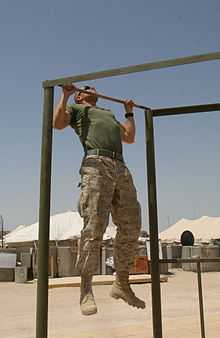Calisthenics

Calisthenics are a form of exercise that consists of a variety of gross motor movements, often rhythmical, generally without using equipment or apparatus. They are intended to increase body strength, body fitness and flexibility through movements such as bending, jumping, swinging, twisting or kicking, using only one's body weight for resistance. They are usually conducted in concert with stretches. When performed vigorously and with variety, calisthenics can provide benefits in the areas of muscular and cardiovascular fitness, in addition to improving psychomotor skills such as balance, agility and coordination.
Groups such as sports teams and military units often perform leader-directed group calisthenics as a form of synchronized physical training (often including a customized "call and response" routine) to increase group cohesion and discipline. Calisthenics are also popular as a component of physical education in primary and secondary schools over much of the globe.
In addition to general fitness, calisthenic exercises are often used as baseline physical evaluations for many military organizations, such as the U.S. Army Physical Fitness Test and the U.S.M.C Physical Fitness Test.
History
The word calisthenics comes from the ancient Greek words kálos (κάλος), which means "beauty", and sthénos (σθένος), meaning "strength". It is the art of using one's body weight and qualities of inertia as a means to develop one's physique. A longstanding urban legend has claimed that the exercise was named after one of its earliest promotors, the Greek historian Callisthenes.[1]
Disciples of Friedrich Ludwig Jahn brought their version of gymnastics to the United States, while Catherine Beecher and Dio Lewis set up physical education programs for women in the 19th century.[1] Organized systems of calisthenics in America took a back seat to competitive sports after the Battle of the Systems, when the states mandated physical education systems.
Common exercises

In addition to the various stretches, some of the more common calisthenic exercises include:
- Performed by bringing one leg forward and almost kneeling on the back leg. Once the front leg creates a perfect 90 degree angle, stand up and alternate legs, keeping the back straight and chest out.
- Jumping Jacks (Star Jumps/Stride Jumps)
- Performed by jumping to a position with the legs spread wide and the hands touching overhead and then returning to a position with the feet together and the arms at the sides. Sometimes known as jumping jacks and stride jumps or side-straddle hops in the US military.
- Performed by entering a squatting position, then using a plyometric jumping movement to jump as high as possible.
- Sit-ups
- Performed by lying down with the back on the floor, knees bent, and bottoms of feet against the floor. The shoulders are then lifted off the floor by tightening abdominal muscles and bringing the chest closer to the knees. The final movement is to lower the back to the floor with a smooth movement. This trains the abdominal muscles.

- Like the sit-up, except instead of bringing the whole torso area closer to the knees, only a concentrated but shorter movement of the abdominals is performed. Shoulder blades are lifted off the floor, and abdominals tightened.
- Performed face down on the floor, palms against floor under the shoulders, toes curled upwards against the floor. The arms are used to lift the body while maintaining a straight line from head to heel. The arms of the subject should go from fully extended in the high position to nearly fully flexed in the low position, while the subject makes sure to avoid resting on the floor. Resting is only done in the high position of the exercise. Chest, shoulders, and triceps are trained with this exercise. By furthering the range of motion, what is often called a push up +, by pushing the shoulders downwards at the top the serratus anterior comes further into play.
- An overhead bar (sometimes called a chin-up bar) is grasped using a shoulder-width grip. The subject lifts their body up, chin level with the bar, and keeping the back straight throughout. The bar remains in front of the subject at all times. The subject then slowly returns to starting position in a slow controlled manner. This primarily trains the lats or upper back muscles, as well as the forearms. An underhand grip variation or chin-up trains both the back and biceps.
- Standing with feet shoulder width apart, the subject squats down as far as possible, bringing the arms forward parallel to the floor. The subject then returns to standing position. Squats train the quadriceps, hamstrings, calves, and gluteals.
- Standing on a platform with an edge where the heels can hang (e.g. a curb), lift the body on the balls of the feet. The subject then slowly returns to starting position. This trains the gastrocnemius and to a lesser degree the soleus. A seated calf-raise trains the soleus.

- Done between parallel bars or facing either direction of trapezoid bars found in some gyms. Feet are crossed with either foot in front and the body is lowered until the elbows are in line with the shoulders. The subject then pushes up until the arms are fully extended, but without locking the elbows. Dips focus primarily on the chest, triceps, and deltoids, especially the anterior portion.
- Performed in a prone position on the ground, the individual raises the legs, arms and upper body off the ground.
- Lying on the back, hands in fists under buttocks, move feet up and down..
- This is the name for holding the 'top' position of a push-up for extended periods of time. The primary muscle involved in this exercise is the rectus abdominis.
See also
- 5BX
- Alexander technique
- Bodyweight exercise
- Dr. Dobb's Journal of Computer Calisthenics & Orthodontia
- Fitness trail
- Gymnastics
- Pilates
- Pull-up (exercise)
- Radio calisthenics
- Sport
References
- ↑ 1.0 1.1 "calisthenics (exercise) -- Britannica Online Encyclopedia". Retrieved 2010-08-04.